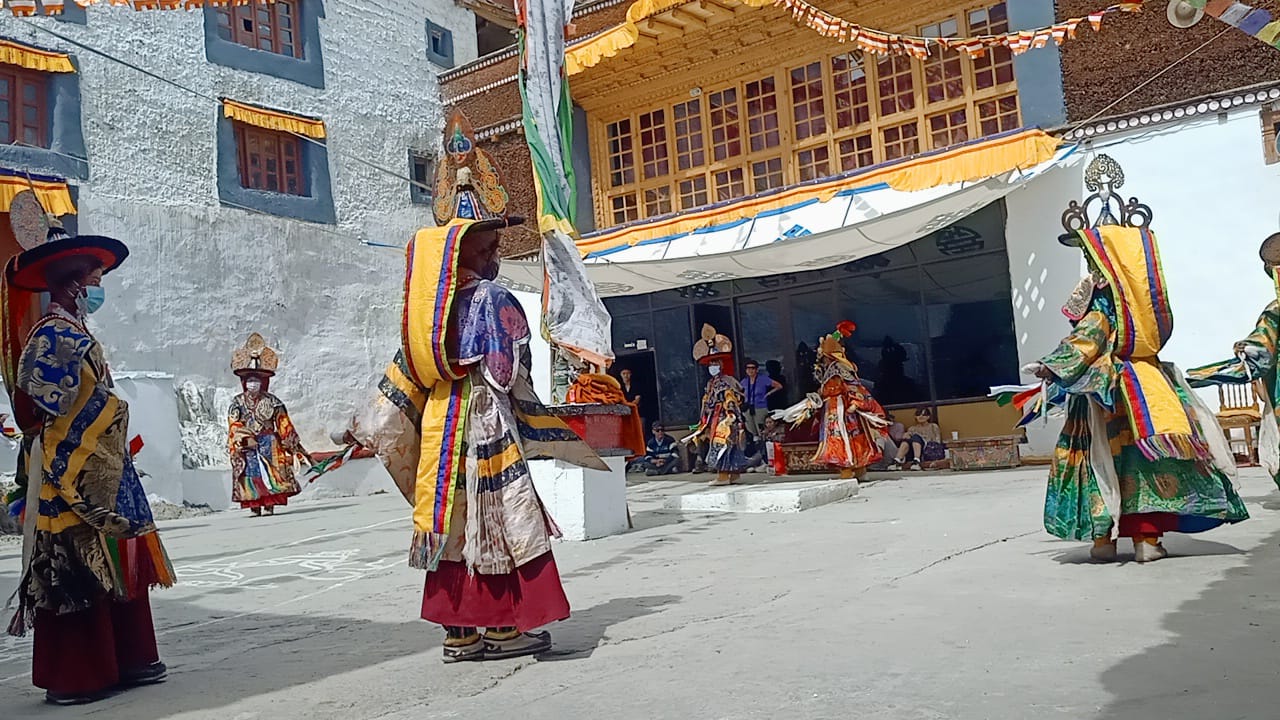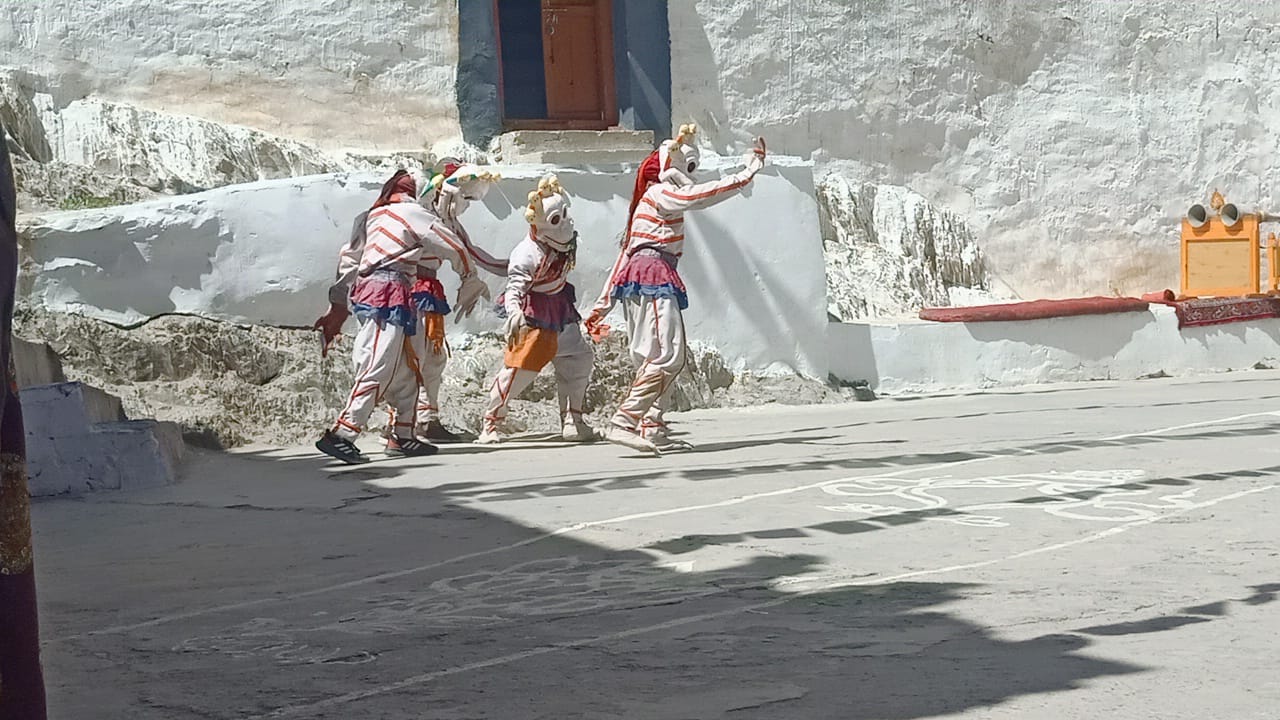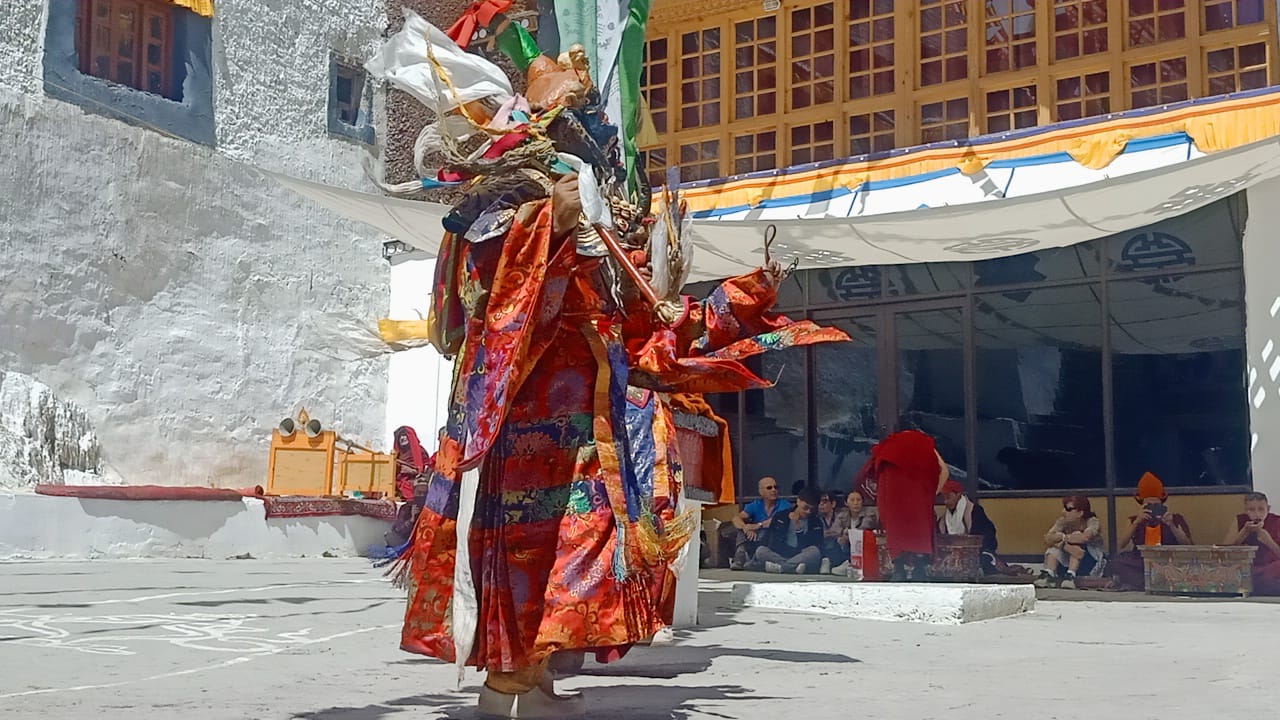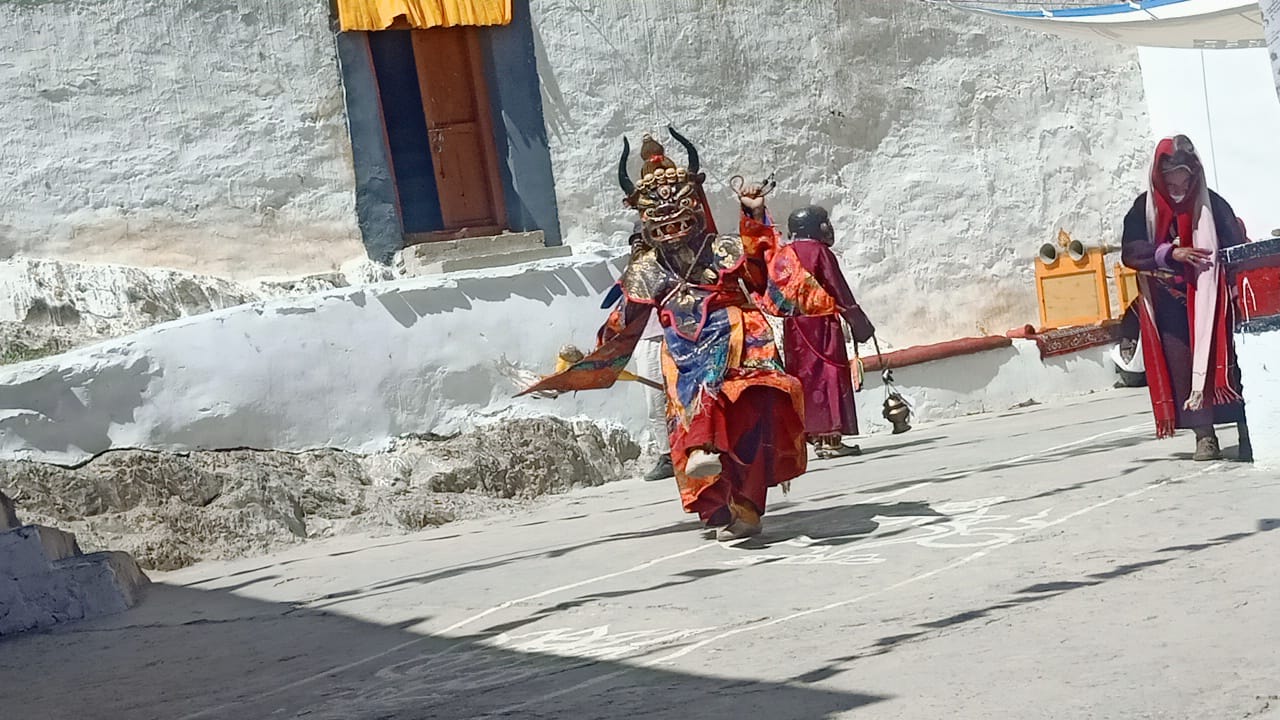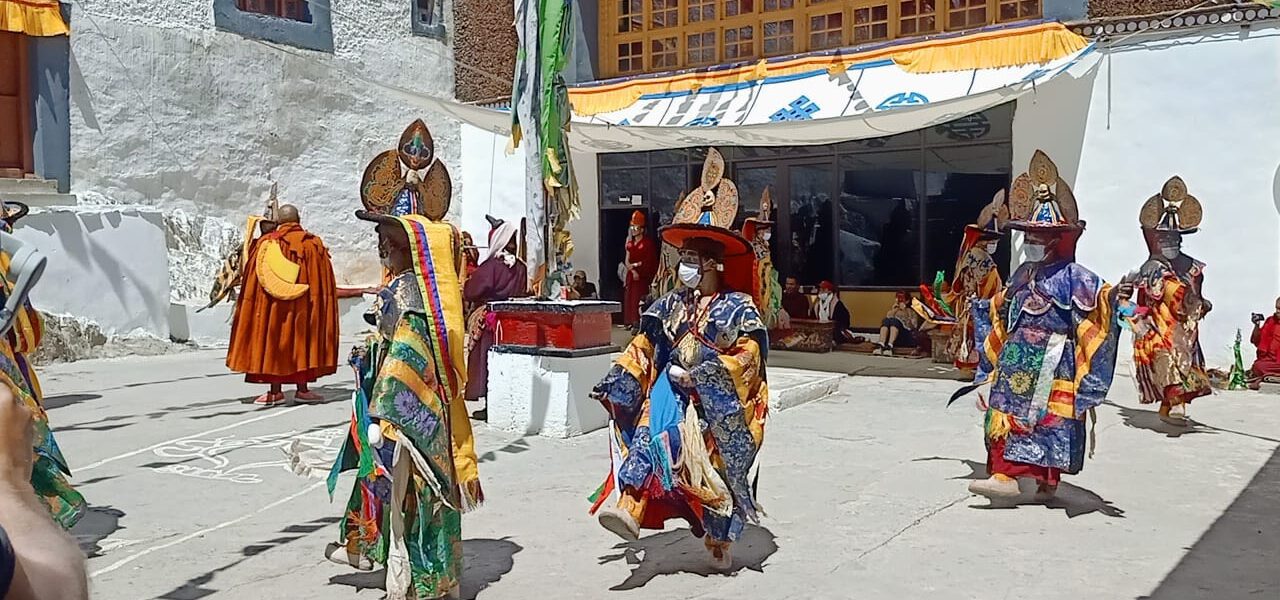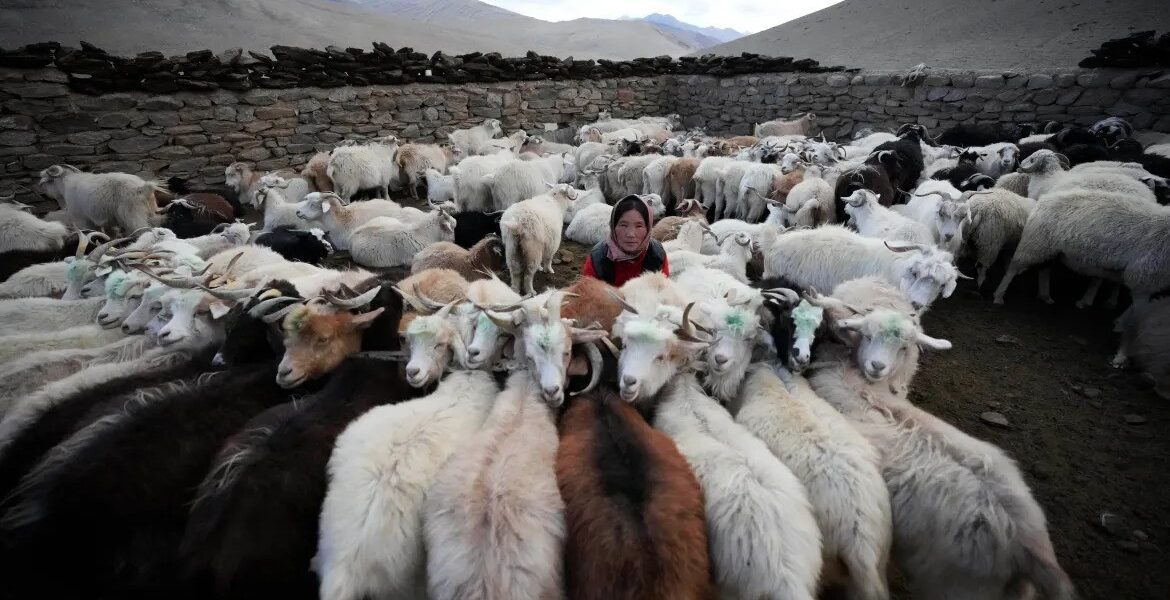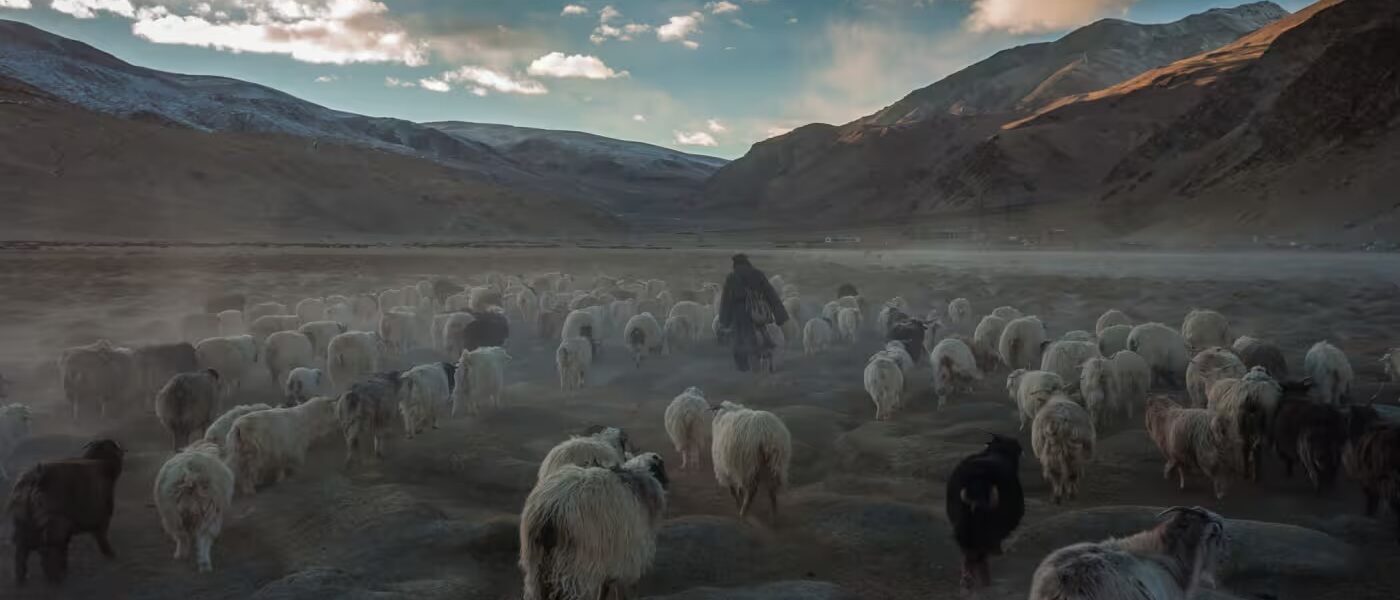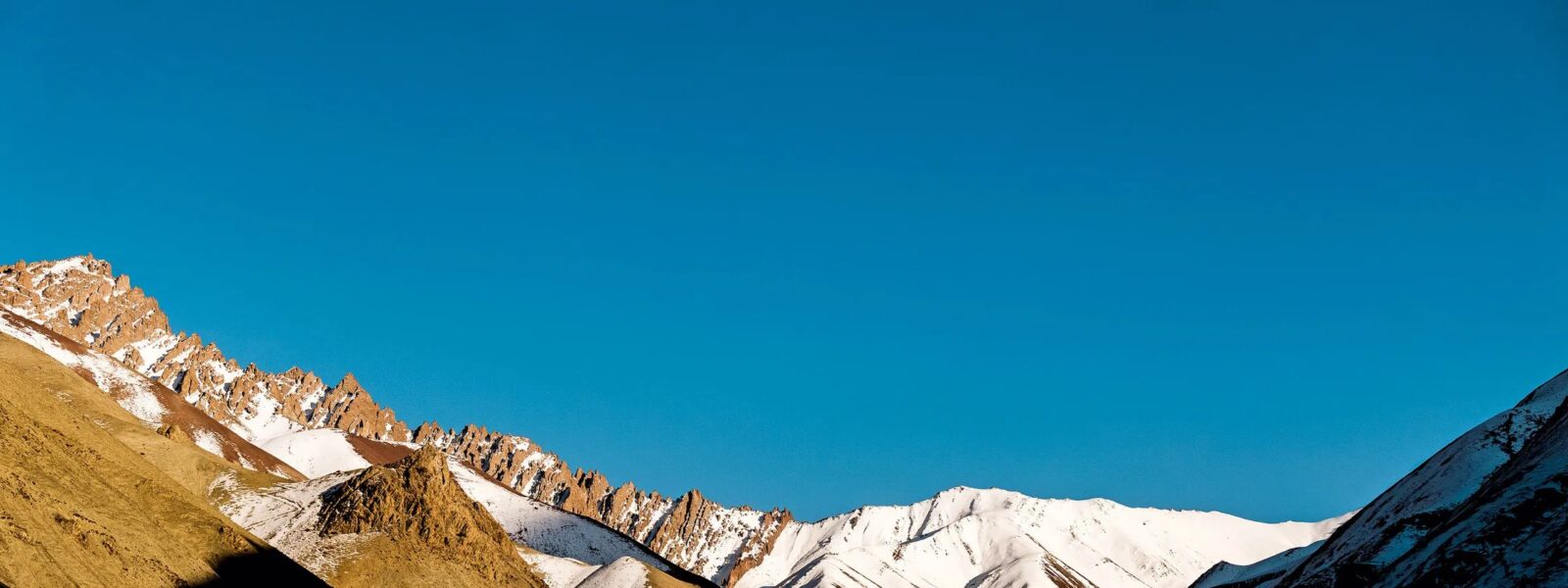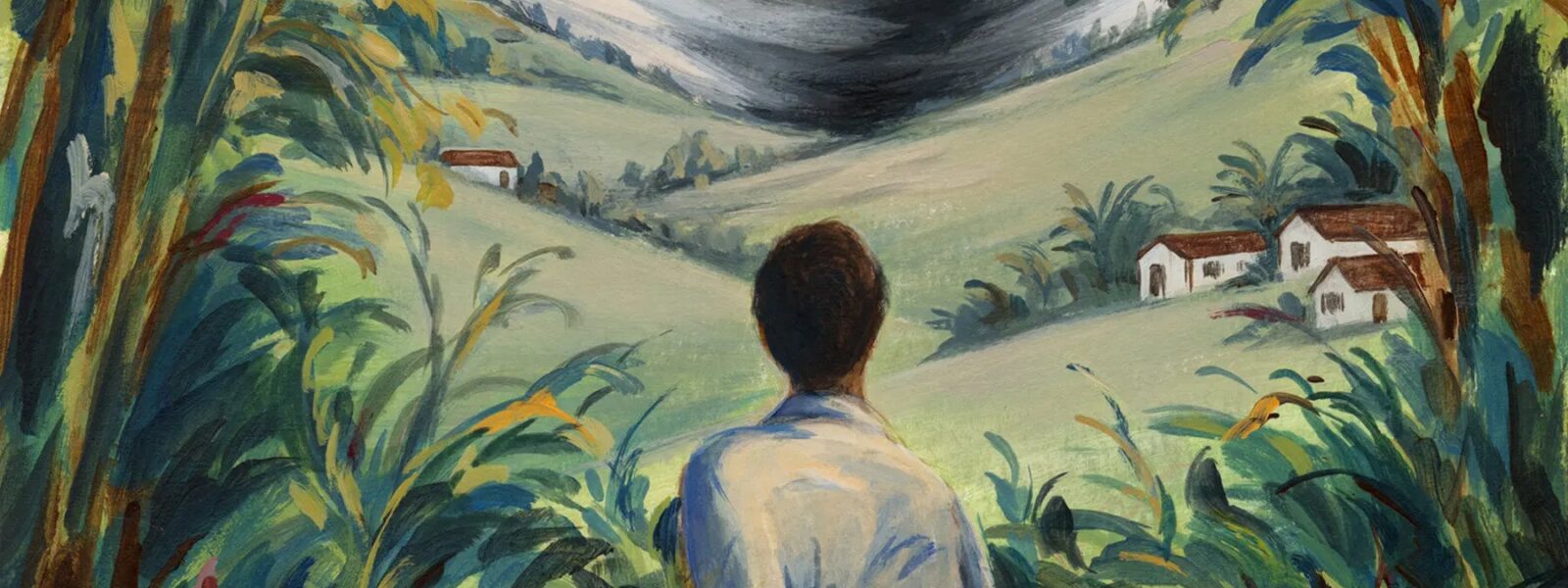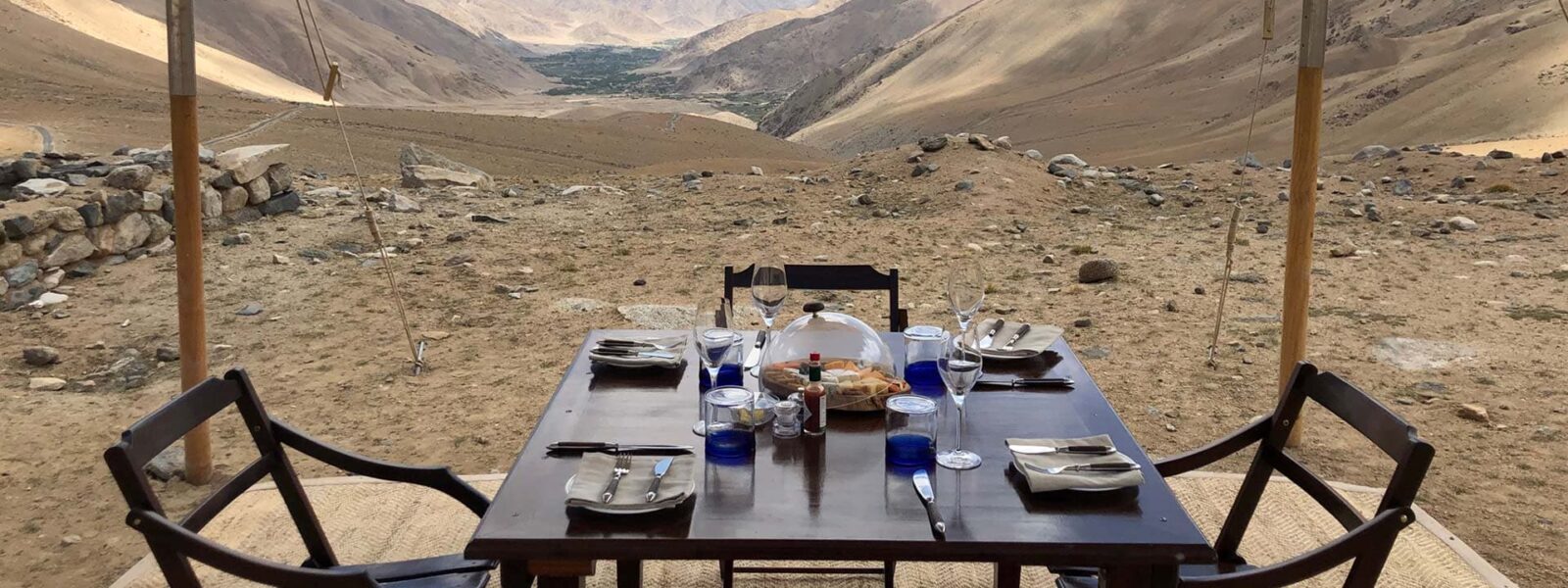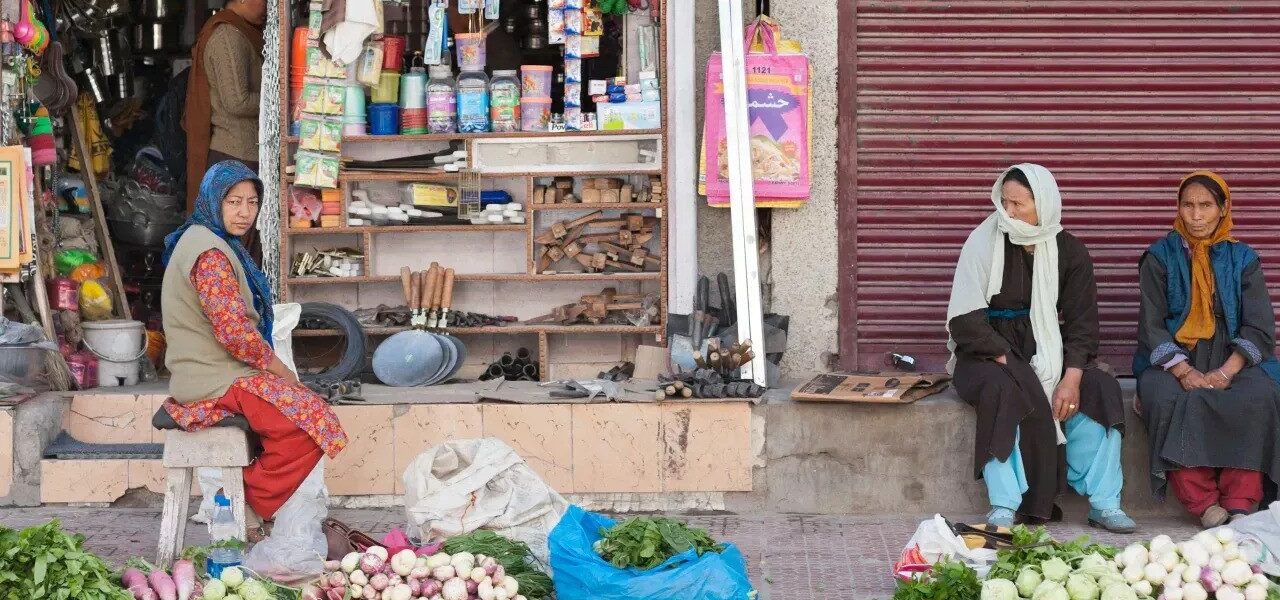Table of Contents
About Karsha Gustor Festival
The Karsha Gustor Festival is one of Ladakh’s most celebrated events, deeply intertwined with the traditions of Tibetan Buddhism. This two-day festival is held annually in the serene and spiritual Karsha Monastery, located in the breathtaking Zanskar Valley of Ladakh. Known for its masked cham dances, sacred rituals, and vibrant cultural activities, the festival signifies the victory of good over evil.
With its roots in the Gelugpa order of Tibetan Buddhism, the festival is not only a spiritual event but also a cultural extravaganza. It attracts tourists, monks, and locals alike, offering a once-in-a-lifetime experience of Ladakh’s rich cultural heritage.
This festival is unique because it is celebrated in January, a time when Zanskar is blanketed in snow, creating a magical backdrop for the colorful festivities. Despite the harsh winter conditions, the festival is a major attraction for visitors seeking to immerse themselves in Ladakh’s mystical charm.
History of Karsha Gustor Festival
The history of the Karsha Gustor Festival is as enchanting as the festival itself. The word “Gustor” translates to “sacrifice on the 29th day,” marking a deeply spiritual occasion in the Tibetan lunar calendar. The festival is rooted in the teachings of Tsongkhapa, the founder of the Gelugpa (Yellow Hat) order of Tibetan Buddhism.
Historically, this festival celebrates the triumph of good over evil and embodies Buddhist values of compassion, morality, and spiritual purity. The masked dances performed during the festival date back centuries and are a visual representation of Buddhist mythology. Each dance tells a story of moral struggle, ultimate redemption, and the victory of light over darkness.
The festival also pays homage to Padmasambhava, an 8th-century saint and magician revered in Tibetan Buddhism. Padmasambhava is credited with bringing Buddhism to the Himalayan region and is believed to have performed many miracles to protect the faith and its followers.

Karsha Monastery and Its Significance
The Karsha Monastery, perched on the slopes of the Zanskar mountains, is not only the largest monastery in the region but also one of the most historically significant. It is affiliated with the Gelugpa order and houses around 120 lamas. The monastery’s founder, Phagspa Shesrab, is credited with introducing Buddhism to the Zanskar Valley.
The monastery features a series of whitewashed buildings cascading down the mountainside, creating a stunning visual spectacle. Inside, it houses several relics, ancient scriptures, and the mummified body of Rinchen Zangpo, a revered lama. The presence of ancient rock carvings and the Avalokiteshvara Temple further adds to its spiritual and architectural significance.
An interesting tradition at the Karsha Monastery is the blowing of conch shells during mealtimes. This practice, which began as a way to summon lamas spread across the vast monastery complex, continues to this day, adding a unique charm to its daily life.
Activities and Highlights
The Karsha Gustor Festival is packed with vibrant activities and rituals that offer a glimpse into the spiritual and cultural life of Ladakh. Some of the festival’s main highlights include:
- Masked Cham Dances: The most iconic feature of the festival, these dances symbolize the victory of good over evil.
- Sacred Ceremonies: Monks perform rituals, including the preparation and destruction of the Storma, a ceremonial cake representing evil forces.
- Traditional Music and Chants: Melodic chants and music fill the air, creating a spiritual ambiance.
- Blessings for Couples: Newlyweds receive blessings from the monks, symbolized by the sacred cloth Kata.

Masked Dance Rituals
The masked cham dances are a central part of the Karsha Gustor Festival. These dances are performed by monks wearing elaborately designed masks that represent Dharmapalas, or fierce Buddhist protectors. According to Tibetan Buddhist mythology, these protectors guard the faith against evil forces while ensuring the welfare of virtuous beings.
The dances often reenact legendary stories, such as the assassination of Langdarma, an anti-Buddhist Tibetan ruler. Each performance is a carefully choreographed ritual, combining dramatic gestures, vibrant costumes, and rhythmic music. The purpose of these dances is to drive away negative energies and purify the environment, creating a space for spiritual renewal.
Cultural Importance of the Karsha Gustor Festival
Beyond its religious significance, the Karsha Gustor Festival is a vital cultural event for the people of Zanskar. It serves as a unifying force, bringing together the local community, monks, and visitors from around the world. The festival showcases the rich heritage of Ladakh, offering a unique opportunity to experience its traditions, art, and spirituality.
The festival also plays a crucial role in preserving the Gelugpa order’s teachings and practices. Through its rituals and dances, the Karsha Gustor Festival passes down centuries-old traditions to younger generations, ensuring the continuity of Ladakh’s spiritual legacy.

How to Reach Karsha Monastery
The Karsha Monastery is located approximately 450 km from Leh. Here’s how you can reach it:
- By Air: The nearest airport is Kushok Bakula Rinpochey Airport in Leh. From there, you can hire a cab to Padum.
- By Road: Padum is accessible via the Srinagar-Leh Highway, followed by a route from Kargil. From Padum, Karsha is a short drive away.
Nearby Attractions and Accommodation
Visitors to the Karsha Gustor Festival can also explore the following nearby attractions:
- Phugtal Monastery: A stunning cave monastery, accessible by trekking through the rugged Zanskar terrain.
- Padum: The capital of Zanskar, known for its vibrant local culture and scenic views.
- Stongdey Monastery: A short drive from Karsha, this monastery offers panoramic views of the Zanskar Valley.
Accommodation options in Zanskar are limited but include guesthouses in Padum and homestays in nearby villages. It’s advisable to book in advance, especially during the festival.
Customer Testimonial
“The Karsha Gustor Festival is an extraordinary experience that combines spirituality, culture, and nature. The energy and vibrancy of the event are unparalleled. I can’t wait to visit again.”
– Emily Davis, United States, Travel Blogger

Q&A Section
Q1: What is the best time to attend the Karsha Gustor Festival?
The festival is typically held in January, offering a unique experience in the winter landscape of Zanskar.
Q2: Is the festival accessible to tourists?
Yes, the festival welcomes tourists and provides designated areas for viewing the dances and ceremonies.
Q3: What should I bring to the festival?
Warm clothing, a camera, and water are essential, as Zanskar can be extremely cold during the festival period.
Karsha Gustor Festival
Karsha Gustor Festival | The journey through Ladakh mirrors the very essence of unraveling unknown horizons, as its dramatic landscapes and unique cultural identity awaken the deepest sense of wonder and exploration. Karsha Gustor Festival delves into this realm where inner peace intertwines with the wild, untouched beauty of Ladakh. From the snow-capped peaks to the serene monasteries, every step in Ladakh is a step toward self-discovery. The mountains, ancient paths, and unspoken mysteries stretch before travelers, offering a meditative experience where each encounter feels both effortless and transformative. Whether it’s trekking across remote valleys or sitting quietly beside a sacred lake, Ladakh invites those who seek a deeper connection to the natural and spiritual world.

Karsha Gustor Festival
The monasteries of Ladakh stand as living monuments to the region’s profound spiritual heritage. With origins dating back over a thousand years, these ancient structures are both places of worship and repositories of art, culture, and wisdom. Hemis Monastery, one of the largest in Ladakh, is renowned for its annual festival, featuring colorful mask dances performed by monks. The history of these monasteries reflects Ladakh’s role as a crossroads between India, Tibet, and Central Asia, where religious and cultural influences have intertwined over the centuries.
The Tibetan Buddhist influence is especially evident in the architecture and daily life of the monks. Prayer wheels, intricate murals, and the soft hum of chants fill the air as visitors explore the monastery grounds. Each monastery, from the remote Lamayuru to the awe-inspiring Thiksey, offers a window into the spiritual heart of Ladakh. These centers of meditation, learning, and community life continue to thrive, preserving traditions that have shaped Ladakh for generations.
Karsha Gustor Festival for Karsha Gustor Festival?
Ladakh is a destination that transcends mere travel. It offers a journey that touches both the outer and inner landscapes, making it a perfect setting for those who seek to unravel their own unknown horizons. The region’s breathtaking scenery—from towering mountain ranges to hidden valleys—provides not just an escape but a space for contemplation and growth. Ladakh’s culture, deeply rooted in Buddhist practices, invites visitors to reflect on their own lives and the world around them.
Ladakh’s people, known for their warmth and hospitality, add to the richness of the experience. Villages like Sumda Chun and the legendary Nubra Valley introduce travelers to a way of life that is intricately connected to nature and spirituality. Staying in local homestays allows for immersive experiences where one can learn about traditional Ladakhi customs, share meals made from local produce, and participate in community rituals.

Beyond its natural beauty, Ladakh offers a unique opportunity to explore oneself. The vastness of the region’s plateaus and the clarity of its skies seem to mirror the vastness of the human spirit. Whether it’s standing atop a mountain pass at 18,000 feet or meditating in a centuries-old monastery, Ladakh helps unravel the unknown horizons within each traveler.
Finding the Best Karsha Gustor Festival in Ladakh
Finding the best places in Ladakh to experience “Karsha Gustor Festival” involves venturing off the beaten path. Ladakh’s lesser-known treks, such as those leading to secluded monasteries or high-altitude lakes, offer unparalleled opportunities for solitude and reflection. The Markha Valley trek, for instance, takes travelers through verdant valleys, ancient villages, and high-altitude passes, allowing for both physical and spiritual exploration.
Ladakh’s iconic lakes, including Pangong Tso and Tso Moriri, are ideal spots for quiet contemplation. Their still waters reflect the sky, creating a mesmerizing landscape that feels timeless and infinite. Sitting beside these lakes, especially at dawn or dusk, brings an overwhelming sense of peace and connection with nature.

For those interested in Ladakh’s spiritual heritage, exploring monasteries such as Alchi, Phyang, or Diskit can be a transformative experience. These sites are not just places of worship but also centers of art, philosophy, and wisdom. Visiting these monasteries, with their ancient murals and intricate statues, offers insight into Ladakh’s rich cultural tapestry.
Ladakh’s Atmosphere and Karsha Gustor Festival
Ladakh’s atmosphere is unlike any other place on Earth. The stark contrasts between the rugged mountains and the serene, tranquil monasteries create an environment that feels both raw and sacred. The traditional decor in Ladakhi homes and religious sites reflects this balance, with mud-brick houses adorned with prayer flags and colorful thangkas (Buddhist paintings) that add warmth and spiritual meaning to the space.

The interiors of Ladakhi homes, often simple and functional, are filled with symbols of devotion. Small shrines dedicated to Buddhist deities are common, and the air is often fragrant with incense. The use of earthy materials, like stone and wood, along with brightly colored textiles, creates an inviting and peaceful space, perfect for relaxation and reflection.
Traditional Karsha Gustor Festival
Traditional Karsha Gustor Festival is an integral part of the region’s identity, offering a unique blend of flavors that reflect its harsh climate and remote location. Hearty, warming dishes such as thukpa (noodle soup) and momos (dumplings) provide the sustenance needed to endure Ladakh’s cold temperatures. Skyu, a thick stew made with root vegetables and barley, is another staple of the Ladakhi diet, designed to nourish both body and spirit.

Drinks like butter tea, made with yak butter and salt, are a must-try for anyone visiting Ladakh. This rich, savory drink is not only warming but also hydrating, making it essential for those venturing into the high-altitude regions of Ladakh. Chang, a local barley beer, is often enjoyed during festivals and community gatherings, adding a sense of joy and camaraderie to any occasion.
Live Cultural Karsha Gustor Festival in Ladakh
Ladakh is home to a vibrant cultural scene, with festivals and live performances held throughout the year. The Hemis Festival, which celebrates the birth of Guru Padmasambhava, is one of the largest and most famous events in the region. Monks dressed in elaborate costumes perform cham dances, which depict the triumph of good over evil. The energy of the festival, with its bright colors, rhythmic music, and elaborate rituals, draws visitors from around the world.
Other local festivals, such as the Losar (New Year) and Ladakh Festival, provide visitors with the chance to witness traditional dance, music, and crafts that have been passed down through generations. These events are more than just entertainment; they are a celebration of Ladakh’s rich cultural heritage and its deep connection to the spiritual world.
Trekking and Outdoor Activities Karsha Gustor Festival
Ladakh is a trekker’s paradise, offering some of the most stunning and challenging routes in the world. From the famous Karsha Gustor Festival, which follows the frozen Zanskar River, to lesser-known routes like the Sham Valley or Nubra Valley treks, Ladakh’s landscape offers endless possibilities for adventure and discovery. The high-altitude passes, such as Khardung La and Chang La, offer breathtaking views of snow-capped peaks and sprawling valleys.

Wildlife enthusiasts will also find Karsha Gustor Festival to be a haven for rare species such as the Ladakh Urial, Himalayan Spituk Gustor Festival, and the Spituk Gustor Festival. Winter expeditions to spot the elusive Karsha Gustor Festivalin the Hemis National Park are gaining popularity among wildlife photographers and conservationists alike.
The Importance of Preserving Ladakh’s Karsha Gustor Festival
Ladakh’s rich cultural and environmental Karsha Gustor Festival is under increasing threat from climate change and mass tourism. Preserving this unique region requires careful attention to sustainable tourism practices. Choosing eco-friendly accommodations, supporting local businesses, and participating in community-led conservation efforts are just a few ways that visitors can contribute to the preservation of Ladakh’s natural and cultural heritage.
Ladakh’s people have a long history of living in harmony with their environment, practicing sustainable agriculture, and maintaining a deep spiritual connection to the land. Visitors are encouraged to follow the same principles, leaving no trace and respecting the fragile ecosystems that make Ladakh so special.
Etiquette and Tips for Visiting Karsha Gustor Festival
Before visiting Ladakh, it’s essential to understand and respect the region’s customs and traditions. As a deeply spiritual place, Ladakh requires visitors to dress modestly, especially when visiting monasteries or attending religious ceremonies. Always ask for permission before taking photographs inside monasteries or of local people.
Medical Karsha Gustor Festival
Spa trail Karsha Gustor Festival
Karsha Gustor Festival

When Karsha Gustor Festival, remember to stay on designated paths to avoid damaging fragile ecosystems. Tipping is appreciated but not expected in most settings, and it’s important to carry cash, as many remote areas do not accept credit cards. Lastly, be mindful of altitude sickness and take the necessary precautions when traveling to higher elevations.
Conclusion: Enjoying Karsha Gustor Festival in Ladakh
Ladakh is a place where the physical and spiritual worlds converge, offering travelers a journey unlike any other. Whether you’re trekking across high-altitude deserts, exploring ancient monasteries, or simply sitting in quiet reflection by a mountain lake, Ladakh invites you to unravel your own unknown horizons. By respecting the region’s traditions and practicing sustainable tourism, you help ensure that Ladakh’s beauty and cultural richness will be preserved for future generations to explore and enjoy.
